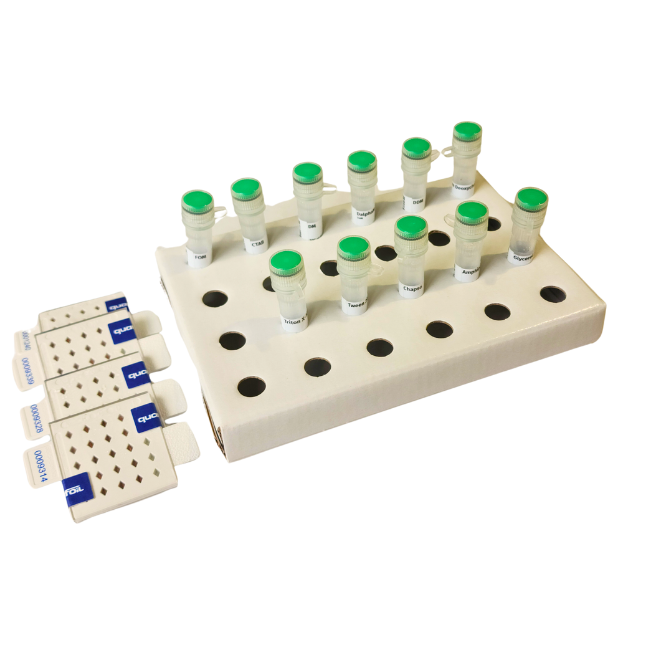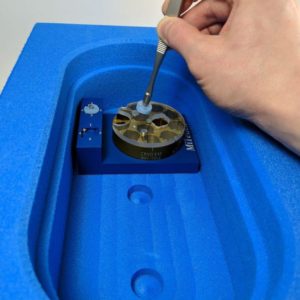Cryo-EM Vitrification Starter Kit
Single particle electron cryo-microscopy (cryo-EM) is a powerful technique to determine the structures of protein complexes down to atomic resolution. The sample in solution is flash-frozen in liquid ethane, forming a thin layer of vitreous ice, in which the sample particles are ideally evenly distributed in random orientation far enough from the air-water interface (pictured).
However, protein sample vitrification for cryo-EM is a major bottleneck. Only the combination of choosing the right grid type, vitrification conditions, protein concentration and additives enables high quality data acquisition in cryo-EM.
The Cryo-EM V-Kit is a Vitrification Starter Kit that offers both a selection of surfactants which have been successfully applied in cryo-EM sample preparation and a selection of Quantifoil Holey Carbon Films to facilitate the search for the optimal vitrification condition for both soluble and membrane proteins.
Learn More Ask Question/Request Quote
Product Information
The Cryo-EM V-Kit contains 10 different surfactants plus glycerol as cryoprotectant and 4 different types of Quantifoil grids. It is designed as a Vitrification Starter Kit to facilitate the search for the optimum vitrification condition and cryo-EM grid for both soluble and membrane proteins.
Learn about Surfactants
The usage of surfactants can be reduced to two benefits:
- Ice quality: The protein solution will better wet the grid because it reduces the surface tension. This ultimately leads to an even and thin vitrified ice layer (if the blotting parameters fit).
- Protein interactions: Proteins tend to adhere to the air-water-interface. This can induce denaturation of parts of the protein and can limit the resolution of the final reconstruction. Surfactants will cover the air-water-interface and therefore prevent proteins from being exposed to the “deadly” air phase[1-4]. Some proteins also adhere to the carbon foil. Addition of detergents can help to “wash” the protein of interest into the hole of the grid, increasing the number of particles per image, which is beneficial for later data processing.
Surfactants can influence the structure and function of your protein. Therefore, make sure that the used surfactant does not impair your protein by biochemical assays and/or negative stain EM. For membrane proteins, lowering the concentration of the additional surfactant might be necessary.
Fluorinated Octyl Maltoside (FOM) was successfully used to determine high resolution cryo-EM maps and is therefore the first choice in optimizing frozen membrane protein specimens.
Learn about grids
The kit contains a vary of grid types. In general, start with Quantifoil™ R 1.2/1.3 on 200 mesh and continue to additional carbon grids. After glow discharging, work quickly to have a freshly glow discharged grid for your experiment.
Learn about the recommended protocols for usage of this kit
Download the Cryo-EM V-Kit Manual to learn about usage protocols and more.
You may also like…
-
Cryo-EM Puck Dewar and Insert
Foam Dewar with cryoEM Puck Holding insert for easy grid transfer. • Easily transfer Cryo Grid Boxes to or...


